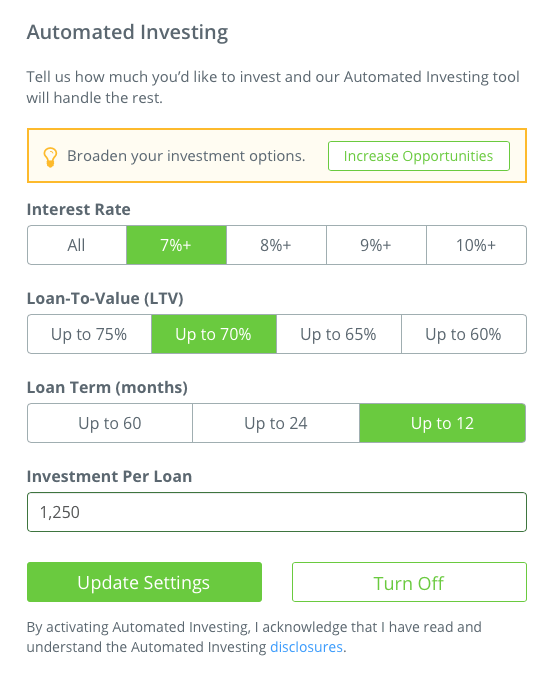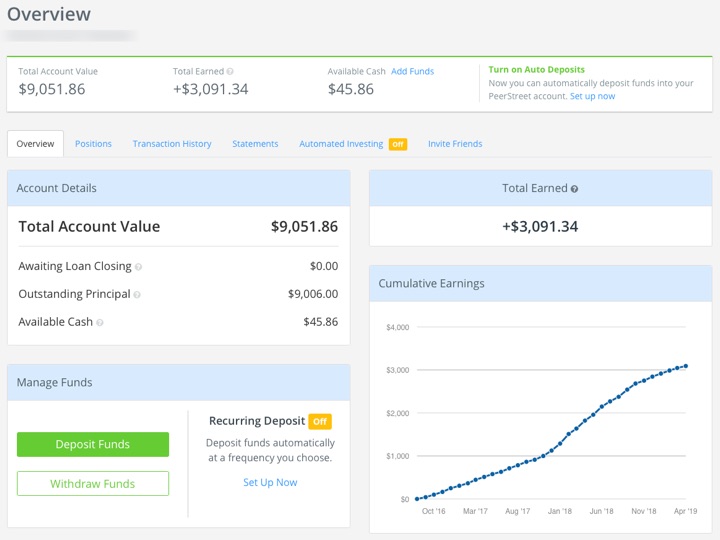Updated April 2019. I started investing in in July 2016. I’ve always like the idea of hard money loans, but I wanted more diversification as opposed to tying all my money up with one single property. For this type of lending, you have to be an . Here are my overall numbers so far, with details below:
- Total invested: $25,000
- Total interest earned: $3,091
- 43 loans made and paid off, 8 remaining active loans, and 2 are in foreclosure.
- Internal rate of return (IRR) of 7.21% as of 4/18/19.
Short-term loans backed by real estate. Real estate equity investors want to take out short-term loans (6 to 24 months) and don’t fit the profile of a traditional mortgage borrower. They are professional investors with multiple properties, need bridge financing, or they are on a tight timeline. As a real-estate-backed loan investor, you lend them money at 6% to 12% and usually backed by a first lien on the property. The borrower stands to lose the equity in their property, so they are incentivized to avoid default. In the worst case, you would foreclose and liquidate the property in order to get your money back. However, this is better than Prosper or LendingClub where it is an unsecured loan and your only recourse is to lower their credit score.
What are PeerStreet strengths? Here are the reasons that I decided to put more a higher amount of money into PeerStreet as compared to other worthwhile real estate marketplace sites:
- Debt-only focus. Other real estate (RE) sites will offer both equity and debt (and things in between). PeerStreet only focuses on debt, and I also prefer the simplicity of debt. There is limited upside but also less downside. Traditionally, this might be called “hard money lending”.
- Lower $1,000 investment minimum. Many RE investment sites have minimums of $10,000 or $25,000. At PeerStreet, $25,000 will get me slices of loans from 25 different real estate properties. You can even reinvest your earnings with as little as $100.
- Greater availability of investments. Amongst all the RE websites that I have joined, PeerStreet has the highest and most steady volume of loans that I’ve seen. I dislike having idle cash just sit there, waiting and not earning interest. They apparently have a unique process where they have a network of lenders that bring in loans for them. They don’t originate loans themselves, they basically buy loans from these partners if they fit their criteria. This steady volume allows the lower $1,000 minimums and more diversification, as well as easy reinvestment of matured loans.
- Automated investing. The above two characteristics allow PeerStreet to run an automated investment program. You give them say $5,000 and they will invest it automatically amongst five $1,000 loans. You can set certain criteria (LTV ratio, term length, interest rate). When a loan matures, the software can automatically reinvest your available cash. I don’t even have to log in.
- Consistent underwriting. You should perform your own due diligence in this area, as you can only feel comfortable with automated investing if you think every loan is underwritten fairly. The riskier loans get higher interest rates. The less-risky loans get lower interest rates. The shady borrowers are turned away. I want to just sit back and let them choose for me.
- Strong venture capital backing. PeerStreet just closed a $30 million Series B round in April 2018. Andreessen Horowitz did a $15 million Series A round in November 2016. Michael Burry was an early seed investor, using $6.1 million of his own money according to TechCrunch. You may recognize this name from .
Here’s a screenshot of the automated investing customizer tool:

What are PeerStreet drawbacks? In my opinion, the main drawback is lower yields. This is just my limited understanding and I may be wrong, but PeerStreet has a network of lenders bringing in these deals and they also need to paid some sort of “finders fee”, so the net yield to the investor feels lower than other sites. You could argue that this is also their secret sauce that brings in the high loan volume (and ideally the ability to be more selective), but at some point the rate is too low to justify the risks being taken.
As of mid-2018, it is also my opinion that too many crowdfunding sites are chasing too few loans, which has been driving down the interest rates offered. I started out being able to find a lot of loans in the 8% to 9% range, but now the more conservative notes are in the 7%-7.5% range. In the current yield environment, my target is an 8% return while also maintaining a loan-to-value ratio of 70% or less.
Here’s the 1-minute video pitch from PeerStreet:
How does PeerStreet make money? As with other real estate marketplace lenders, they charge a servicing fee. PeerStreet charges between 0.25% and 1%, taken out from the interest payments. This way, PeerStreet only gets paid when you get paid. When you invest, you see the fee and net interest rate that you’ll earn. In exchange, they help source the investments, set up all the required legal structures, service the loans, and coordinate the foreclosure process in case of default. In some cases, the originating lenders retains a partial interest in the loan (“skin in the game”). Here’s a partial screenshot:

What if PeerStreet goes bankrupt? This is the same question posed to LendingClub and Prosper, and their solution is also the same. The loans are held in a bankruptcy-remote entity and will continue to be serviced by a third-party even in a bankruptcy event. From their FAQ:
PeerStreet also holds loans in a bankruptcy-remote entity that is separate from our primary corporate entity. In the event PeerStreet no longer remains in business, a third-party “special member” will step in to manage loan investments and ensure that investors continue to receive interest and principal payments. Additionally, investor funds are held in an Investors Trust Account with City National Bank and FDIC insured up to $250,000.
Tax forms? For tax year 2018, I received both a 1099-INT and a 1099-OID. Basically, both include your gains that will be taxed at ordinary income rates (like bank account interest). Here’s what PeerStreet says:
PeerStreet investors will be issued a consolidated Form 1099 for the income distributed from their investment positions. Investors may receive one or more of the following types of 1099 form:
1099-OID for notes with terms longer than one year (at the time of issue)
1099-INT for notes with terms less than one year (at the time of issue)
1099-MISC for incentives, late fees or other income, if more than $600.
My personal performance. I started with a $10,000 investment in 2016 and then added another $15,000 in 2017 for a total of $25,000. This way, each of my loans was less than 5% of the total portfolio. Everything was set for automatic reinvestment whenever a loan in paid back or the interest adds up to $1,000. Starting in June 2018, I stopped reinvesting my proceeds as I felt that the rates being offered were starting to become too low when considering the gap between other bond alternatives. (For example, I think a 7% rate at a 75% LTV is not good enough.) If the rate premium improves, I will deposit more money back into the account.
Here is a screenshot of my account:

As of this writing 4/18/2019, my internal rate of return (IRR) is 7.21% annualized net of all fees and taking into account the short periods where my cash was idle. However, 2 out of my 51 total loans (works out to about 4%) are in some phase of the foreclosure process. These loans are all less than 70% LTV, but I don’t know what the final recovery amount will be. I expect my final IRR to be in the 6% to 7% range. In my experience, this is a critical difference with private real estate loans. You can’t make a few clicks and get your money back. I may have to wait a year or longer if the loan requires a property takeover and sale. This is why it’s a good idea to diversify across many $1,000 loans.
Bottom line. PeerStreet offers high-yield, short-term loans backed by private real estate. As compared to traditional “hard money lending”, accredited investors can diversify with $1,000 minimum investment per property, automated reinvestment, and steady nationwide loan volume. In exchange, PeerStreet charges a servicing fee between 0.25% and 1%, taken out of the interest charged to the borrower. The returns you see in the listing are net of their fees.
If you are interested and are an accredited investor, you can sign up and before depositing any funds or making any investments.
“The editorial content here is not provided by any of the companies mentioned, and has not been reviewed, approved or otherwise endorsed by any of these entities. Opinions expressed here are the author’s alone. This email may contain links through which we are compensated when you click on or are approved for offers.”
from .
Copyright © 2018 MyMoneyBlog.com. All Rights Reserved. Do not re-syndicate without permission.